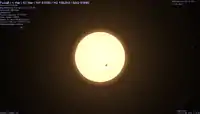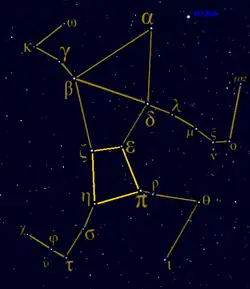Pi Herculis
Pi Herculis (π Her, π Herculis) is a third-magnitude star in the constellation Hercules. As one of the four stars in the Keystone asterism (see yellow quadrangle), it is one of the constellation's more easily recognized. It has an apparent visual magnitude of +3.2,[11] which is visible to the naked eye and makes it one of its brighter members. The Hipparcos satellite mission estimated its distance at roughly 115 parsecs from Earth, or about 377 light years away. The overall reduction in the star's visual magnitude due to extinction from the intervening matter is 0.11.[6]
| Observation data Epoch J2000.0 Equinox J2000.0 | |
|---|---|
| Constellation | Hercules |
| Right ascension | 17h 15m 02.83436s[1] |
| Declination | +36° 48′ 32.9843″[1] |
| Apparent magnitude (V) | +3.15[2] |
| Characteristics | |
| Spectral type | K3 II[3][4] |
| U−B color index | +1.66[2] |
| B−V color index | +1.45[2] |
| Variable type | undetermined[5] |
| Astrometry | |
| Radial velocity (Rv) | –25.57 ± 0.20[6] km/s |
| Proper motion (μ) | RA: –27.29[1] mas/yr Dec.: +2.82[1] mas/yr |
| Parallax (π) | 8.66 ± 0.12[1] mas |
| Distance | 377 ± 5 ly (115 ± 2 pc) |
| Absolute magnitude (MV) | −2.10+0.13 −0.12[7] |
| Details | |
| Mass | ≥3.7[5] M☉ |
| Radius | 72[5] R☉ |
| Luminosity | 1330[8] L☉ |
| Surface gravity (log g) | 1.42[9] cgs |
| Temperature | 4170[10] K |
| Metallicity [Fe/H] | –0.07[9] dex |
| Rotational velocity (v sin i) | 6.12[10] km/s |
| Other designations | |
| Database references | |
| SIMBAD | data |
Properties

Pi Herculis is a bright giant star with a stellar classification of K3 II.[3][4] P.C. Keenan and R. E. Pitts (1980) graded it as a spectral type K3 IIab[12] and it is sometimes listed with this alternate classification. The star is enormous compared to the Sun, having a mass that is 4.5 times solar and a radius approximately 60 times depending on which wavelength the star's angular diameter is measured at. Due to limb darkening, all giant and supergiant stars present unique challenges when measuring their photosphere. This orange-hued giant shines with 1,330 times the luminosity of the Sun.[8] It is a low-amplitude photometric variable star showing a typical change of roughly 0.0054 in magnitude over a 24-hour period.[13]
Possible planetary system
Low-amplitude radial velocity variations with a period of 613 days in the bright giant have suggested the possible presence of a substellar companion. If this is really due to a low-mass object, such a companion would be as small as 0.027 Solar masses (27 times the mass of Jupiter, probably a brown dwarf) and 3 astronomical units away from the bright primary. A substellar companion is only one of several hypotheses to explain the star's behaviour. Most likely the cause of the variation is weak pulsation of the star's atmosphere.[8]
With a luminosity more than 1,000 times that of the Sun, an orbit where a planet could be habitable would be located 37 AU away from Pi Herculis—in Solar System terms, halfway between Neptune and Pluto's orbits. On the other hand, a putative companion would orbit in a scorching region and would be as hot as a planet would at 0.08 AU around a Sun-like star. In any case it's likely that it would soon be swallowed up by the expanding giant.[5]
| Companion (in order from star) |
Mass | Semimajor axis (AU) |
Orbital period (days) |
Eccentricity | Inclination | Radius |
|---|---|---|---|---|---|---|
| b (unconfirmed) | 27 MJ | 3 | 613 | 0.05 | — | — |
References
- van Leeuwen, F. (November 2007), "Validation of the new Hipparcos reduction", Astronomy and Astrophysics, 474 (2): 653–664, arXiv:0708.1752, Bibcode:2007A&A...474..653V, doi:10.1051/0004-6361:20078357
- Mermilliod, J.-C. (1986). "Compilation of Eggen's UBV data, transformed to UBV (unpublished)". Catalogue of Eggen's UBV Data. SIMBAD. Bibcode:1986EgUBV........0M.
- Morgan, W. W.; Roman, Nancy G. (November 1950), "Revised Standards for Supergiants on the System of the Yerkes Spectral Atlas", Astrophysical Journal, 112: 362–364, Bibcode:1950ApJ...112..362M, doi:10.1086/145351
- Ivanov, Valentin D.; et al. (April 2004), "A Medium-Resolution Near-Infrared Spectral Library of Late-Type Stars. I", The Astrophysical Journal Supplement Series, 151 (2): 387–397, arXiv:astro-ph/0311596, Bibcode:2004ApJS..151..387I, doi:10.1086/381752
- Hatzes, Artie P.; Cochran, William D. (March 1999). "Long-period, low-amplitude radial velocity variations in the K giant star pi Herculis: rotation, substellar companion or non-radial pulsations?". Monthly Notices of the Royal Astronomical Society. 304 (1): 109–118. Bibcode:1999MNRAS.304..109H. doi:10.1046/j.1365-8711.1999.02288.x.
Whereas the short-term variability is undoubtedly due to radial and/or non-radial pulsations, the long-term variability is still open to interpretation with viable hypotheses consisting of rotational modulation by stellar surface structure, planetary companions, or non-radial pulsations
- Famaey, B.; et al. (January 2005), "Local kinematics of K and M giants from CORAVEL/Hipparcos/Tycho-2 data. Revisiting the concept of superclusters", Astronomy and Astrophysics, 430: 165–186, arXiv:astro-ph/0409579, Bibcode:2005A&A...430..165F, doi:10.1051/0004-6361:20041272
- Carney, Bruce W.; et al. (March 2008), "Rotation and Macroturbulence in Metal-Poor Field Red Giant and Red Horizontal Branch Stars", The Astronomical Journal, 135 (3): 892–906, arXiv:0711.4984, Bibcode:2008AJ....135..892C, doi:10.1088/0004-6256/135/3/892
- Kaler, James B., "Pi Herculis", Stars, University of Illinois, retrieved 2012-03-13
- Cenarro, A. J.; et al. (January 2007), "Medium-resolution Isaac Newton Telescope library of empirical spectra - II. The stellar atmospheric parameters", Monthly Notices of the Royal Astronomical Society, 374 (2): 664–690, arXiv:astro-ph/0611618, Bibcode:2007MNRAS.374..664C, doi:10.1111/j.1365-2966.2006.11196.x
- Hekker, S.; Meléndez, J. (2007). "Precise radial velocities of giant stars. III. Spectroscopic stellar parameters". Astronomy and Astrophysics. 475 (3): 1003–1009. arXiv:0709.1145. Bibcode:2007A&A...475.1003H. doi:10.1051/0004-6361:20078233.
- "* pi. Her". SIMBAD. Centre de données astronomiques de Strasbourg. Retrieved 2010-11-15.
- Keenan, P. C.; Pitts, R. E. (April 1980), "Revised MK spectral types for G, K, and M stars", Astrophysical Journal Supplement Series, 42: 541–563, Bibcode:1980ApJS...42..541K, doi:10.1086/190662
- Henry, Gregory W.; et al. (September 2000), "Photometric Variability in a Sample of 187 G and K Giants", The Astrophysical Journal Supplement Series, 130 (1): 201–225, Bibcode:2000ApJS..130..201H, CiteSeerX 10.1.1.40.8526, doi:10.1086/317346
